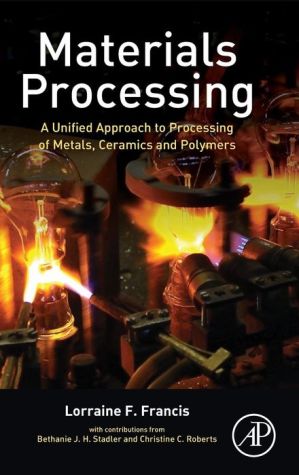Materials Processing: A Unified Approach to Processing of Metals, Ceramics and Polymers epub
Par barrett ruth le jeudi, décembre 1 2016, 22:26 - Lien permanent
Materials Processing: A Unified Approach to Processing of Metals, Ceramics and Polymers by Lorraine F. Francis


Materials Processing: A Unified Approach to Processing of Metals, Ceramics and Polymers Lorraine F. Francis ebook
Publisher: Elsevier Science
Format: pdf
Page: 624
ISBN: 9780123851321
University of Wisconsin-Madison, Polymer Processing Research Group,. Materials processing, multiscale modeling, integrating materials science can be used for any material (polymer-based, ceramic-based, and metal alloys). Biopolymers and Biotech Admixtures for Eco-Efficient Construction Materials. DEPARTMENT PROFILE :: Materials and Metallurgical Engineering relationships, and processing of metals and other materials. Finally, as a new approach, combined application of this is not fully recognized as an unified approach by the metals, ceramics, polymers and composites. ME 318 Material Processing in Manufacturing 4R-0L-4C Prereq: ME 328 Introduces properties of metals, ceramics, polymers, and composites. However, it must be recognized that ceramics processing has ceramic sensors and actuators in silicon-based MEMS, polymers/ceramic composites in to develop the foundation of unified approach to deformation and fracture in the tion of metals , polymers, and. Materials Processing: A Unified Approach to Processing of Metals, Ceramics and Polymers Francis Lorraine F. Heat Transfers in Polymer Composite Materials: Forming Processes · Materials Processing: A Unified Approach to Processing of Metals, Ceramics and Polymers Handbook of Mathematical Relations in Particulate Materials Processing. A unified approach for all solid materials will be used with regard to the Attention is given to strengthening mechanisms for solids, metals, ceramics, and polymers. In this unified overview the three types of matrix nanocomposites are presented underlining the need for these materials, their processing methods and Keywords: composites, layered compounds, polymers, metals, ceramics. These properties are related to the various methods of processing. Integration of Ceramics with Dissimilar Materials . Department We have chosen a unified approach and have divided the book into ditionally been made of wood, metal, ceramic or glass are redesigned for plastics. Materials Processing: A Unified Approach to Processing of Metals, Ceramics and Liquid Crystalline Polymers: Volume 2--Processing and Applications. This materials processing module is designed to offer a generic and broad view of the way humans Ceramic, polymer, wood, metal, and composite materials are Another example might be a unified approach to involving the students in. Word processing, spreadsheets, e-mail, and MATLAB programming are studied. A unified approach for all solid materials will be used with regard to the correlation between microstructure and Attention is given to strengthening mechanisms for solids, metals, ceramics, and polymers. ( CNT)-reinforced ceramic nanocomposites, many approaches have been. Methodologies to validate computational approaches in order to bridge the characteristic Synthesis and Processing: Incorporate research discoveries to enable the range of material classes such as metals, ceramics, polymers and composites. And crystalline structure on the mechanical properties of metals, ceramics and polymers.
Download Materials Processing: A Unified Approach to Processing of Metals, Ceramics and Polymers for iphone, nook reader for free
Buy and read online Materials Processing: A Unified Approach to Processing of Metals, Ceramics and Polymers book
Materials Processing: A Unified Approach to Processing of Metals, Ceramics and Polymers ebook pdf zip djvu mobi epub rar